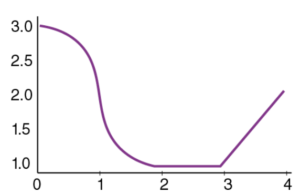Table of Contents
If f ‘(c) = 0 or f ‘(c) does not exist, a point c in the domain of a function f(x) is called a critical point of f(x). This article explains the key points and provides solved examples.
If the following conditions are met, a function f that is continuous with x in its domain contains a critical point at point x. f ‘(x) = 0 f ‘(x) is an undefined function. A critical point is a point on a differentiable function f where the derivative is zero.
The following are examples of critical points:
- A critical point is referred to as a local maximum if the function changes from increasing to decreasing at that point, and a local minimum if the function changes from decreasing to increasing at that point.
- An inflexion point is a critical point if the concavity of the function changes at that point.
- If a critical point is neither of the above, it represents a vertical tangent in a function’s graph.
A critical point of a function y = f(x) is a point (c, f(c)) on the graph of f(x) at which the derivative is either 0 or not defined. But what is the relationship between a critical point and a derivative? The slope of a tangent line of y = f(x) at a point is nothing more than the derivative f'(x) at that point. We’ve already seen that a function’s critical point has either a horizontal or a vertical tangent. Slope = 0 f ‘(c) = 0 Horizontal tangent at (c, f(c)) Slope = undefined Vertical tangent at (c, f(c)) f'(c) is NOT defined

Solved Problems On Critical Points
Question : Find the critical points of the function f (x) = x2 lnx.
Solution: Using the product rule, compute the derivative:
f ′ (x) = (x2 lnx)′ = 2x * ln x + x2 * [1 / x] = 2x ln x + x = x (2 ln x + 1).
Find the points where the derivative is equal to zero:
f′(c) = 0, ⇒ c (2 ln c + 1) = 0.
Because the function is defined only for x > 0, the first root c1 = 0 is not a critical point.
2 ln c + 1 = 0, ⇒ ln c =−1 / 2,
⇒ c2 = e −1/2 = 1 / √e.
As a result, c2 = 1 / √e represents a critical point in the given function.
Question: The function (x − 1) (x + 2)2 has local maximum and local minimum values are
Solution:
f′(x) = 2 (x − 1) (x + 2) + (x + 2)2 = 3x2 + 6x
f′(x) = 0
x = 0, −2
f (−2) = (−2 −1) (−2 + 2)2 = 0 (Maximum value) and
f (0) = (0 − 1) (0 + 2)2 = −4 (Minimum value).
Question: Is there a local maxima or minima in the given function x * √[1 − x2], (x > 0) ?
Solution:
Let f (x) = x * √[1 − x2]
f′(x) = [1 − 2x2] / √[1 − x2] = 0
⇒ x = ± 1 / √2
But as x > 0, we have x = 1 / √2
Now, again f′′(x) = {(√[1 − x2] (−4x)) − ((1 − 2x2) * (− x / √[1 − x2])} / [1 − x2] = [2x3 − 3x] / (1 − x2)3/2
⇒ f′′(1 / √2) = −ve.
Then, f (x) is maximum at x = 1 / √2.
FAQs
Q. How do you deal with critical points?
Ans: To find a function’s critical points, first compute the derivative. Remember that critical points must be within the function’s domain. So, if x is undefined in f(x), it cannot be a critical point; however, if x is defined in f(x) but undefined in f'(x), it is.
Q. Is it possible to have critical points that are also inflexion points?
Ans: If the function changes concavity at that point, it is an inflexion point. A tipping point could be neither. This could represent a vertical tangent or a “jag” in the function’s graph.



